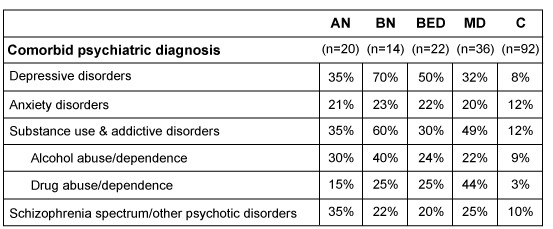Passage
A common misconception in medicine is that eating disorders present similarly in males and females. Research suggests that this is untrue: males meeting diagnostic criteria for eating disorders are more likely than females to have another psychiatric illness, demonstrate a later age of onset, and engage in excessive exercise. They are less likely to engage in purging behaviors, be diagnosed by clinicians, or seek treatment. When males do enter treatment, they are generally further along in the course of the illness.The classification of eating disorders in males according to the Diagnostic and Statistical Manual of Mental Disorders, Fifth Edition (DSM-5) has recently been debated. Research suggests that one very common manifestation of eating disorder etiology in males, called muscle dysmorphia (MD) , includes an obsession with a larger and more muscular body, which contrasts with the thin, idealized body for females with eating disorders. Characterized as a subset of body dysmorphic disorder, MD is more recently conceptualized as part of a spectrum of eating disorders; however, it is still classified under the obsessive-compulsive and related disorders umbrella in the DSM-5.One study applied the latest DSM-5 diagnostic criteria for anorexia nervosa (AN) , bulimia nervosa (BN) , binge eating disorder (BED) , and MD to the medical records of male veterans treated in Veterans Administration (VA) hospitals across the United States from 2000 to 2015. The study (Table 1) found a significant increase in psychiatric comorbidity compared to controls (C) .Table 1 Prevalence of Psychiatric Disorders for Eating Disorder and MD Cases and Controls in a National Sample of Male Veterans Treated at VA Hospitals from 2000 to 2015

-Which of the following hypothetical findings from a follow-up study evaluating eating disorders in males is most consistent with the data presented in Table 1?
A) The proportion of males diagnosed with MD was roughly equivalent to the proportion of females diagnosed with AN.
B) Half of the individuals who met the diagnostic criteria for BED also met the criteria for BN within the past year.
C) Individuals diagnosed with BED were less likely to also meet criteria for depression than individuals diagnosed with AN.
D) Individuals meeting diagnostic criteria for MD were more likely to abuse anabolic steroids than those meeting diagnostic criteria for any other eating disorder.
Correct Answer:
Verified
Q63: Passage
Major depression is a mood disorder that
Q64: Passage
Major depression is a mood disorder that
Q65: Passage
A common misconception in medicine is that
Q66: Passage
Major depression is a mood disorder that
Q67: Passage
Visual perception involves the organization and interpretation
Q69: Passage
Visual perception involves the organization and interpretation
Q70: Passage
Major depression is a mood disorder that
Q71: Passage
Psychophysiology examines the relationship between the properties
Q72: Passage
Psychophysiology examines the relationship between the properties
Q73: Passage
Psychophysiology examines the relationship between the properties
Unlock this Answer For Free Now!
View this answer and more for free by performing one of the following actions

Scan the QR code to install the App and get 2 free unlocks

Unlock quizzes for free by uploading documents